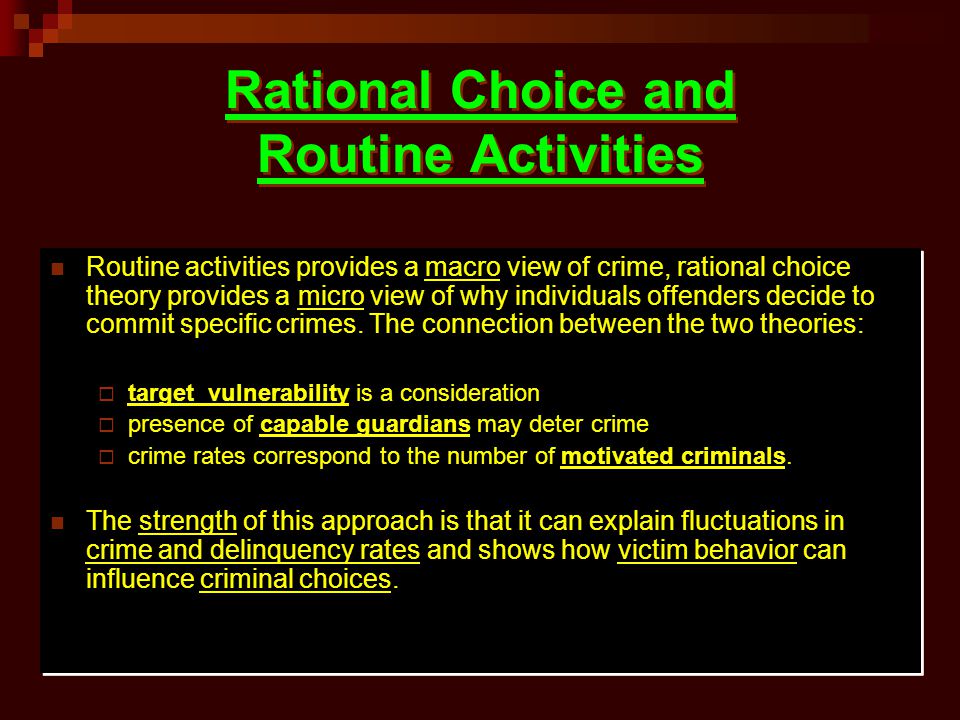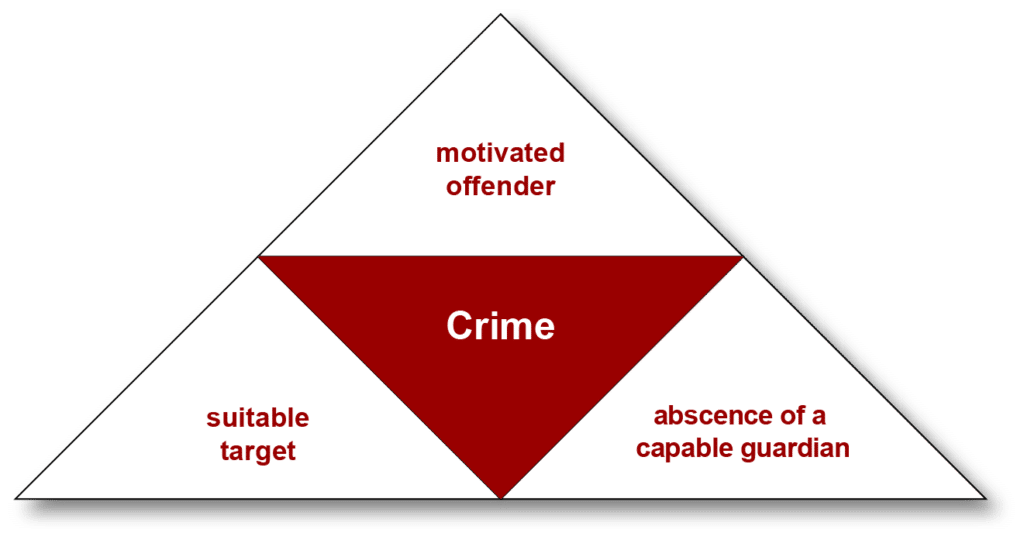Does Choice Theory or Routine Activities Theory Describe Delquncy Best
Routine activities theory is based on the idea that offenders make rational choices about whether to commit a crime. The routine activity theory and rational choice theory are essential in the field of security.

Chapter Four The Development Of Rational Choice Theory Ppt Video Online Download
A crime will only be committed if a likely offender thinks that a target is suitable and a capable guardian is absent.

. This differs from a majority of criminological theories which focus on explaining why some people commit crimesthat is the motivation to commit crime rather than how criminal events are produced. A routine activity approach Lawrence E. But who are the offenders.
Furthermore crimes rate if generally proportional to the. The situational nature of crime and how engaging in high risky behaviors increases proximity exposure to violence increases the likelihood that youth will find themselves in situations. The balance between likely risks and rewards influences offenders target selection Clarke 1983.
Routine Activity Theory of real policies and practices aimed at altering the necessary elements that make the existence of a crime possible and thereby preventing it Tilley FERNANDO MIRÓ 2009. How does rational choice theory dovetail with routine activities theory. According to Brantingham and Brantingham 1984 the level of risks is one of the factors that.
The routine activity theory suggests that crime requires three elements for it to take place. Developed by Cohen and Felson 1979 routine activities theory requires three elements be present for a crime to occur. The theory has been extensively applied and has become one of the most cited theories in criminology.
Cohen and Felson explained that crime rates could vary without actual changed in the number of potential offenders or offender motivation. In their seminal article Social change and Routine activity theory first formulated by crime rate trends. Routine activity theory is a sub-field of rational choice criminology developed by Marcus Felson and Lawrence Cohen.
The model consisting the operationalisations predicts self-reported delinquency. Routine activities theory 1. First there is a motivated offender.
It was first proposed by Marcus Felson and Lawrence E. Routine Activity Theory is mainly a macro theory of victimization. Cohen in their explanation of crime rate changes in the United States between 1947 and 1974.
Rational Choice Theory. Crime is offense - specific. Routine Activity Theory focuses on situations of crime.
Routine Activity Theory says that crime is normal and depending on the circumstances crime will be committed. What are routine activities. Cultural factor to Asian friendship may influence the dynamics of peer influence.
Resurgence of assumptions of the nature of human beings. Routine activity theory says that crime is normal and depends on the opportunities available. To summarize routine activities theory is a theory of crime events.
This theory was used by Cohen and Felson 1979 to explain the rising crime rates in the United States. Before the advent of routine activities theory nearly all criminological theory had focused solely on factors that motivate offenders to behave criminally such as biological sociological and economic conditions that. Routine activity theory is a sub-field of crime opportunity theory that focuses on situations of crimes.
The idea is that crime is the result of peoples everyday behavior of the way in which offenders and victims go about their daily lives. Routine Activities Theory Routine Activity Theory is a sub-field of rational choice and criminology developed by Marcus Felson and Lawrence E Cohen. Peer involvement in deviant activities predicts self-reported delinquency the most.
One key insight of routine activities theory Cohen and Felson 1979 is that a criminal event requires a convergence in space and time of a likely offender someone motivated to commit crime a suitable target someone or something that the likely offender is attracted to offend against and the absence of capable guardians persons who are able and. Routine activities of youth that involve unstructured peer socializing in the absence of authority figures Research in routine activities theory supports. Routine activities refer to generalized patterns of social activities in a society ie spatial and temporal patterns in family work and leisure activities.
Crime is a product of opportunity. It is the offenders assessment of a situation that determines whether a crime will take place. Classical theory also called R ational or Choice Theory is based on the early writings of Cesare Beccaria 17381794 and Jeremy Bentham 17481832.
Routine activity theory like the related lifestyle-exposure theory emerged as a key theoretical approach in criminology in the late 1970s. The problem of juvenile delinquency in keeping with this viewpoint makes juvenile delinquency an individual problem and not a social problem. Routine activity theory looks at crime from an offenders point of view.
This paper will analyze aspects of the above theories for the purpose of seeing which best explains the cause of cybercrime. A motivated offender with criminal intentions and the ability to act on these inclinations a suitable victim or target and the absence of a capable. Secondly there is a suitable target and finally there is an absent capable guardian.
Routine activities theory is a theory of crime events. Crime is not something extraordinary that requires a deep psychological analysis. Routine activities theory is a subsidiary of rational choice theory.
If a target is not protected enough if it is worth the reward crime will happen. Routine Activity Theory is operationalised into suitable variables to explain delinquency. The theory has three assumptions.
Rational Choice Theory The Rational Choice Theory more commonly referred to as Choice Theory is a view as to why criminals commit crimes and more importantly why juveniles choose to be delinquent. Crime happens because of poverty. This explanation assumes that crime results from a rational process in which offenders make decisions and choices often planning their criminal activity so as to maximize the benefits and.
Recurrent prevalent activities that provide for basic population and individual needs. Although at first glance this distinction may appear inconsequential it has important implications for the research and. The Rational Choice Theory as more commonly referred to as Choice Theory is a view as to why criminals commit crimes and more importantly why juveniles choose to be delinquent.
A key idea is that the structure of routine. It tells us who is more likely to be victimized. The problem of juvenile delinquency according to this viewpoint which makes juvenile delinquency an individual problem on and not a social problem.
There is a correlation between criminal victims and offenders thus patterns found by Routine Activity Theorists could be misleading. The theory of rational choice theory examines offender decision making and the factors that affect it such as assessments of risks rewards and morality of various behaviors Clarke 1983. Routine activities theory differs from other criminological theories in a fundamental way.
Crime triangle also called Problem Analysis Triangle. Terms in this set 8 Routine Activities Theory. These theories include social learning theory low self-control theory general strain theory frustration aggression hypothesis routine activity theory and situational crime prevention theory.
Cohen Felson 1979 Popular due to its connection with victimology ecological crime prevention approach- 1980s.

Routine Activity Theory Wikiwand

No comments for "Does Choice Theory or Routine Activities Theory Describe Delquncy Best"
Post a Comment